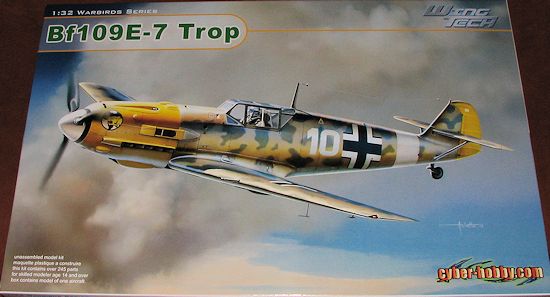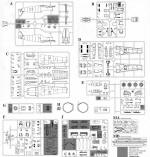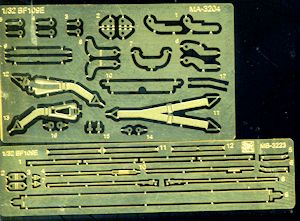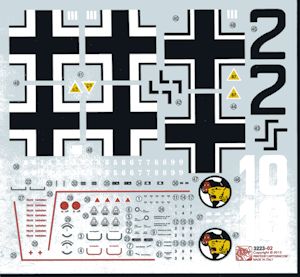
Cyber-Hobby 1/32 Bf-109E-7/trop
| KIT #: | 3223 |
| PRICE: | $56.50 SRP |
| DECALS: | Two options |
| REVIEWER: | Scott Van Aken |
| NOTES: |

| HISTORY |
Based on the earlier Jumo powered 109s, the E model saw the introduction of the more powerful DB.601 engine, providing between 1,000 and 1,100 horsepower. It was enough to transform the previous model into a much more potent fighting machine. Aside from the new cowling and the movement of the coolant radiators under the wings, the E model 109 was, in most respects, the same airframe, making it a relatively smooth transition on the assembly line.
The E model was built in four major variants. The E-1 and E-3 were built concurrently with the E-1 having all machine gun armament and the E-3 having two MG FF cannon in the wings. This was superceded by the E-4 which introduced a heavier canopy with an armor plate behind the pilot and a reinforced wind screen. It was al so cannon armed like the E-3. The E-4 style canopy was often retrofitted to the earlier versions. This is the subject of this kit. The last major E version was the E-7. It generally had a closed off spinner which had an opening for an engine mounted cannon that was never fitted to the E model. It also had plumbing added for a drop tank and fittings for a bomb rack under the main fuselage. This variant started seeing unit service in August of 1940. Often the earlier versions were retrofitted with this option, though none were so fitted in time to participate in the Battle of Britain, where the additional range would have been most welcome.
The E model was sold to several other countries and soldiered on with the Luftwaffe in North Africa and Russia well into 1941/42.
| THE KIT |
 Adding
to their growing list of 109Es is the 109E-7/trop. Most if not all the bits in
this kit have been used in other versions, however, this one includes the
additional trop filter that was unique to this variant. The E-7 was plumbed for
the drop tank and had the ability to carry a bomb on that lower rack. The kit includes two etched frets
with one having to do with cockpit bits like the harness, and some of the
control hinge parts. The other fret continues with the control hinges and has
the large strap for the drop tank.
Adding
to their growing list of 109Es is the 109E-7/trop. Most if not all the bits in
this kit have been used in other versions, however, this one includes the
additional trop filter that was unique to this variant. The E-7 was plumbed for
the drop tank and had the ability to carry a bomb on that lower rack. The kit includes two etched frets
with one having to do with cockpit bits like the harness, and some of the
control hinge parts. The other fret continues with the control hinges and has
the large strap for the drop tank.
 Anyway, this kit has perhaps the most detailed
cockpit of any of the 1/32 109E kits on the market. The cockpit floor includes
spars to help with the proper fitting and angle of the wings. The kit is
designed with a complete engine, which are the same sprues used with the Bf-110
kit as the engines are basically the same. The kit includes full engine mounts,
separate oil coolers and a detailed lower cowling. The engine can be displayed
with or without the cowling parts attached and is cemented to the fuselage in
the latter part of construction. There are full wing cannon with separate
covers. Flaps and slats and ailerons are also separate with some of these parts
having etched metal hinges. This was something I didn't like about the early big
scale Trumpeter kits so it will be interesting to see how this works out on this
one.
Anyway, this kit has perhaps the most detailed
cockpit of any of the 1/32 109E kits on the market. The cockpit floor includes
spars to help with the proper fitting and angle of the wings. The kit is
designed with a complete engine, which are the same sprues used with the Bf-110
kit as the engines are basically the same. The kit includes full engine mounts,
separate oil coolers and a detailed lower cowling. The engine can be displayed
with or without the cowling parts attached and is cemented to the fuselage in
the latter part of construction. There are full wing cannon with separate
covers. Flaps and slats and ailerons are also separate with some of these parts
having etched metal hinges. This was something I didn't like about the early big
scale Trumpeter kits so it will be interesting to see how this works out on this
one.
I found it interesting that the inner wheel well area is made of DS plastic. The real area is, I believe, either leather or canvas and could be easily removed to gain access to the wing structure. The landing gear legs include separate brake lines made of plastic, which looks a lot more realistic than photo etch. The etched metal hinges extend to the rudder and elevators with this kit having not only an elevator bell-crank, but also lines leading from it into the fuselage.
The cockpit canopy has two different styles of armor
plate and can be posed open if one wishes. This includes the small spring cable
that one sees in photos to hold the canopy op en.
en.
Instructions are superbly drawn with the usual Gunze and Model Master paint references. Since it seems there is always at least one glitch, it would be worth while to verify the part you are about to cement. There are just two markings options provided, both of them from North Africa in 1941 and both with JG.27. These are in the desert colors of RLM 78/79/80, but it may also be that these planes used Italian colors so the choice is yours. Both have yellow noses, yellow rudders and white fuselage bands along with white spinners, making for some colorful aircraft. The decal sheet is well done and if neither scheme appeals, you should be able to find something else as the E-7 was also used on the Eastern Front.
| CONCLUSIONS |
For years we have had but two rather elderly E model 109s in this scale; one from Hasegawa and one from Matchbox. Now, we get two very well done kits from Eduard and Cyber-hobby. Both have a lot to offer and I guess it depends on one's likes or dislikes as to which to pick. The Cyber-hobby has more detail than what is offered with the Eduard kit in terms of having the full engine and greater detail in the cockpit as the major selling points. Frankly, I can't think of any 109 fan who wouldn't be pleased with this kit. I think that this one will be the choice of many 109 modelers for those reasons and it will make for a beautiful display piece when one is done.
September 2013
Thanks to www.dragonmodelsusa.com for the preview kit. Get yours today at your local retailer.
If you would like your product reviewed fairly and quickly, please contact me or see other details in the Note to Contributors.